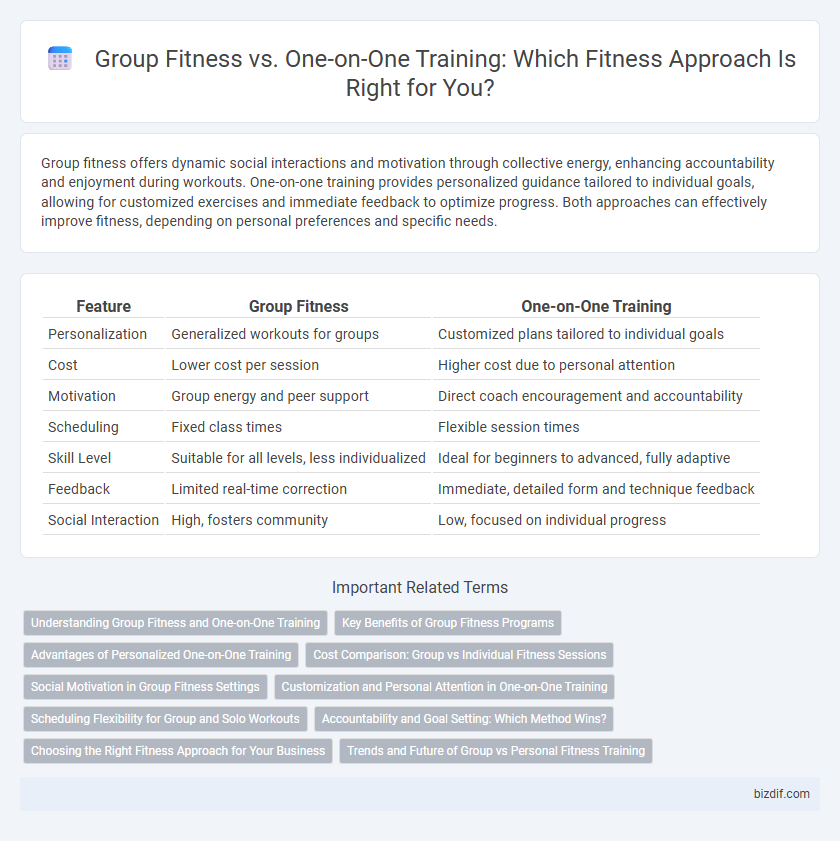Group fitness offers dynamic social interactions and motivation through collective energy, enhancing accountability and enjoyment during workouts. One-on-one training provides personalized guidance tailored to individual goals, allowing for customized exercises and immediate feedback to optimize progress. Both approaches can effectively improve fitness, depending on personal preferences and specific needs.
Table of Comparison
| Feature | Group Fitness | One-on-One Training |
|---|---|---|
| Personalization | Generalized workouts for groups | Customized plans tailored to individual goals |
| Cost | Lower cost per session | Higher cost due to personal attention |
| Motivation | Group energy and peer support | Direct coach encouragement and accountability |
| Scheduling | Fixed class times | Flexible session times |
| Skill Level | Suitable for all levels, less individualized | Ideal for beginners to advanced, fully adaptive |
| Feedback | Limited real-time correction | Immediate, detailed form and technique feedback |
| Social Interaction | High, fosters community | Low, focused on individual progress |
Understanding Group Fitness and One-on-One Training
Group fitness classes provide a dynamic environment where participants benefit from collective motivation, structured routines, and guided instruction tailored to varying skill levels. One-on-one training offers personalized attention, customized workout plans, and real-time feedback to address individual goals and physical limitations. Understanding these differences helps optimize fitness outcomes by aligning workout formats with personal preferences and fitness objectives.
Key Benefits of Group Fitness Programs
Group fitness programs enhance motivation through collective energy and social support, fostering consistent workout habits. These sessions offer cost-effective access to expert trainers, ensuring professional guidance and structured routines for diverse fitness levels. The dynamic environment in group classes improves accountability and encourages participants to push their limits, leading to improved cardiovascular health and overall stamina.
Advantages of Personalized One-on-One Training
Personalized one-on-one training offers customized workout plans tailored to individual fitness levels, goals, and health conditions, maximizing effectiveness and safety. Close supervision by a trainer ensures correct technique, reducing injury risk and promoting faster progress compared to group fitness settings. Individualized attention also enhances motivation and accountability, leading to consistent adherence and better long-term results.
Cost Comparison: Group vs Individual Fitness Sessions
Group fitness sessions typically offer a more budget-friendly option, averaging $15 to $30 per class, compared to individual personal training sessions that can range from $50 to $120 per hour depending on the trainer's expertise and location. The cost-effectiveness of group training is enhanced by shared resources and instructor attention, making it ideal for participants seeking motivation and social interaction without a high financial commitment. Conversely, one-on-one training provides personalized workout plans and immediate feedback, justifying its higher price point for those seeking tailored fitness solutions and faster progress.
Social Motivation in Group Fitness Settings
Group fitness classes harness social motivation by creating an engaging environment where participants encourage each other, boosting consistency and effort. The camaraderie and collective energy in group settings increase accountability and make workouts more enjoyable, leading to higher adherence rates. In contrast, one-on-one training offers personalized attention but lacks the dynamic social reinforcement found in group sessions, which can be a critical motivator for many individuals.
Customization and Personal Attention in One-on-One Training
One-on-one training offers unparalleled customization by tailoring workout plans to individual fitness levels, goals, and medical considerations, ensuring maximum effectiveness and safety. Personal attention from trainers in one-on-one sessions allows for real-time technique correction and motivation, reducing injury risk and boosting progress. Unlike group fitness, where workouts must accommodate a range of abilities, one-on-one training delivers a focused, adaptive approach that accelerates results.
Scheduling Flexibility for Group and Solo Workouts
Group fitness classes offer fixed schedules that require participants to align their availability with class times, fostering a sense of community but limiting individual flexibility. One-on-one training provides personalized scheduling options tailored to the client's availability, enabling more consistent workout routines and accommodating last-minute changes. Prioritizing scheduling flexibility enhances adherence to fitness goals by matching workout times with personal commitments and lifestyle preferences.
Accountability and Goal Setting: Which Method Wins?
Group fitness classes foster accountability through peer motivation and scheduled sessions, encouraging consistent attendance and collective goal achievement. One-on-one training offers personalized goal setting with tailored feedback, enhancing individual commitment and progress tracking. For accountability and goal attainment, one-on-one training typically delivers more focused, customized support, while group fitness excels in social motivation and shared commitment.
Choosing the Right Fitness Approach for Your Business
Group fitness classes foster community engagement and offer cost-effective solutions for scaling client participation, making them ideal for businesses targeting a broad audience. One-on-one training delivers personalized programs tailored to individual goals and needs, enhancing client retention and satisfaction, which benefits premium service models. Evaluating your business goals, client demographics, and resources is essential to selecting the optimal fitness approach that maximizes revenue and client outcomes.
Trends and Future of Group vs Personal Fitness Training
Group fitness training continues to grow in popularity due to its social motivation, cost-effectiveness, and diverse class offerings such as HIIT, yoga, and cycling. One-on-one personal training trends emphasize customized workout plans, wearable technology integration, and virtual coaching to enhance individualized results. Future fitness trends predict a hybrid model combining group energy with personalized attention through AI-driven programs and immersive virtual reality experiences.
Group Fitness vs One-on-One Training Infographic

 bizdif.com
bizdif.com